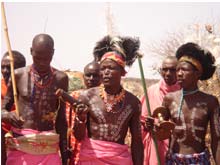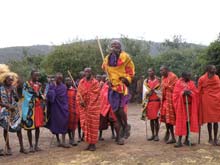Tribal tales from East Africa
By Swetha Amit | 25 Apr 2012
A visit to Africa would be incomplete without an interactive session with one of the tribal clans. Reading about them, their race, ethnicity and culture is altogether different from interacting with them in person. Not wanting to miss such an opportunity, we eagerly set off with our guide on this exciting expedition. There are several tribal groups which constitute the population of the Dark Continent. We were fortunate to pay a home visit to two such clans, which proved to be an enriching experience.
 The colourful clan of Samburu: Samburu is situated in the Northern Province of Kenya. After a short drive through dense jungle, we were escorted to the the little world of the Samburu tribes, set amidst the wild. The men, women and children wore colourful attire and jewellery, which added a vibrant spark to their otherwise plain surroundings. They received us warmly with a vivacious dance. There was flawless coordination between the performers who were thorougly enjoying themselves. The village head then gave us a brief tour of the village. He spoke fluent English and patiently answered questions about their unique lifestyle.
The colourful clan of Samburu: Samburu is situated in the Northern Province of Kenya. After a short drive through dense jungle, we were escorted to the the little world of the Samburu tribes, set amidst the wild. The men, women and children wore colourful attire and jewellery, which added a vibrant spark to their otherwise plain surroundings. They received us warmly with a vivacious dance. There was flawless coordination between the performers who were thorougly enjoying themselves. The village head then gave us a brief tour of the village. He spoke fluent English and patiently answered questions about their unique lifestyle.
Home sweet home: The dwellings of the Samburu tribes were small rectangular or circular huts, to distinguish between the two different kinds of tribes. The Samburu tribes resided in the rectangular huts while the Turkana clan lived in the round ones.
The entrances to the homes were low, signifying that they were for sitting or sleeping. The primary material used for constructing the houses was soft wood fetched from the mountains behind the jungles, where the beloved God of the Samburu clan was believed to reside.
The huts were built solely by women. On entering one of the huts, we were greeted by a delicious smell. A family of seven were seated on the floor gearing up for their afternoon meal. With friendly gestures and warm smiles they signalled us to join them for the feast. However, time constraints did not permit us to do so. As we left, we couldn’t help but feel touched by their warmth and hospitality. We walked down further into the village and learnt more about their customs and traditions.
Women, cows and marriage: We were informed that men practised polygamy, a trend which originated from their ancestors. At weddings, it is a custom for the bridegroom-to-be to give around 20 cows in exchange for the bride. We found this similar to the dowry system prevailing in India, except that it worked the other way around. Age eligibility for men is 25 years and above and for women over 16 years.As we observed the latter, we noticed some of them wore long chains in their ears. We learnt that it was a symbolic representation of their marital status.
Livestock and living: The tribes were dependent on their cattle for their living. Therefore it was vital to protect them from the clutches of hungry lions roaming the forests. The men narrated incidents of big cats entering the village and spiriting away cattle at night, causing immense anxiety to the dwellers. This led them to place a dog on watch which would warn them of such attacks. A fascinating fact was that the tribals drank blood from their cattle as part of their daily diet.
 School and Stone Age: We had an opportunity to visit the village school. This was not a formal classroom with four solid walls and a ceiling, but one under a tree with the blue sky, warm sun and chirping birds looking down. It had 20 children supervised by one teacher, who taught them English and Maths. The little ones welcomed and entertained us with songs. We in turn gave them cream biscuits as a token of our appreciation.
School and Stone Age: We had an opportunity to visit the village school. This was not a formal classroom with four solid walls and a ceiling, but one under a tree with the blue sky, warm sun and chirping birds looking down. It had 20 children supervised by one teacher, who taught them English and Maths. The little ones welcomed and entertained us with songs. We in turn gave them cream biscuits as a token of our appreciation.
Back at the village we were shown how fire was created by causing friction between two sticks. It reminded us of our school days where we were taught how prehistoric men did the same during the Stone Age. We thanked the village head for his time and patience and made our way back to our lodges after an intriguing learning experience about a set of individuals who thrived amidst nature. Next on our itinerary was a trip to the homes of the warrior clan Maasais.
Getting close to the Maasai tribe and nature: A representative of the Maasais accompanied us on the long walk to their abode. He engaged us in friendly and informative conversation during the walk and enabled us to learn interesting facts about their way of living. He pointed out plants and shrubs that the clan used for medicinal and day-to-day purposes. Various kinds of cacti are used as glue and also to feed the cattle. The aloe vera, in particular, is utilised for healing purposes. The morning glory was apparently used as toilet paper, whereas some shrubs were utilised as mosquito repellents.
 Warriors of the jungle: We soon reached the Maasai village and were given a grand welcome. They performed their famous warrior dance with loud chants and cries. This was very different from the one displayed by the Samburu tribes. The jig of the Maasai had the men jumping as high as they could. Their attire too had different streaks and shades. After the performance, we ventured into the village. It was comprised around 200 inhabitants, fragmented into 20 families living in 45 houses. Since they all possessed the same grandfather they were considered to belong to the same clan. We paid a house visit to one of the families.
Warriors of the jungle: We soon reached the Maasai village and were given a grand welcome. They performed their famous warrior dance with loud chants and cries. This was very different from the one displayed by the Samburu tribes. The jig of the Maasai had the men jumping as high as they could. Their attire too had different streaks and shades. After the performance, we ventured into the village. It was comprised around 200 inhabitants, fragmented into 20 families living in 45 houses. Since they all possessed the same grandfather they were considered to belong to the same clan. We paid a house visit to one of the families.
Huts, hardship and wedding vows: The huts were round and built close to each other. The primary construction material is cowdung and they are built solely by women. We gathered that the Maasai tribe moved out of their homes every nine years due to termites destroying their huts.
The lives of the Maasai were largely dependent on their cattle and livestock. Like the Samburu tribes, they too thrived on milk and blood extracted from their healthy cows. While the men tended to the cattle and goats, the women engaged in domestic chores and bringing up their children.
Men were known to marry at the age of 25 and women from 18 years onwards. The men from the Maasai tribe exchanged ten cows in return for their brides. Polygamy is a common practice amongst this clan as well. Married women symbolised their marriage by wearing anklets. Widows differed by wearing just a singular anklet.
Taming a lion: We gaped in awe at this particular custom. Acclaimed as a warrior clan, every Maasai boy has to go through this journey of self-discovery to prove himself worthy as a man. At the tender age of 15, the boys leave their homes and live in the wild. They eat nothing but leaves, grass and wild berries and the open jungle becomes their home. Sometimes they move along with a herd of wild buffalos or zebras. Before turning 18, they are required to kill a lion and bring back its teeth, claws or mane, to prove their valour and maturity at becoming a man. Their return to the tribal community is celebrated with great pomp and splendour.
Studies and a little spark: The Maasai tribe has a primary school for children. For secondary studies, the children are sent to Nairobi. The local school had proper classrooms, blackboards and children-friendly charts pertaining to subjects taught, which included Swahili, English, maths, science, social studies and religion (Christianity). We ended our visit with the Maasai giving us another demonstration of how to light a fire by rubbing two sticks together.
We couldn’t help but marvel at the fact that the Maasais depended on nature for all their needs while we had become slaves to products that came with fancy packaging and branding. They seemed happy and content with the simplicity of their life and taught visitors a valuable lesson on how to coexist in harmony with nature. Our riveting visit came to an end and we thanked their representative for giving us a great opportunity to interact with their clan. As we glanced back at their village, we realised how their lives appeared surreal in comparison to ours.
Kenya undoubtedly is a magical experience and such discovery-laden excursions into the wild was what probably attracted millions across the globe to step in and explore its wilderness.
How to reach Samburu
By road: One can rent an open-top mini bus or a Safari van with a tour guide from Nairobi. It is about a five-hour drive.
By air: Samburu is also accessible by daily flights from Nairobi which takes around 45 minutes.
How to reach Masai Mara
By road: A four-wheel drive vehicle is strongly recommended which can be rented from Nairobi along with a tour-guide. The drive would take around six hours.
By air: There are flights available from Nairobi which takes around 45 minutes. However this will prove to be expensive and will also rob one of the privilege of enjoying an adventurous trip through the best reserves of Africa.
Best time to visit
The best time to visit these reserves would be between the months of July and September. The Great Migration from Serengeti to Masai Mara occurs around this time. This would provide a good opportunity to view wildlife in plenty as well. It is best to avoid the rainy season which falls during the months of April-May and November-December.
Cost of the tour
Depending on the trav
el agency and the number of days, the tour cost can vary anywhere between US$2,500 to US$3,000.
One should remember to tip one’s guide on an everyday basis as he plays a vital role in ensuring your safety and comfort during the trips through the jungles.
Some useful tips
- .Adhere to your guide’s instructions.
- Carry plenty of water with you.
- Carry essential medicines, especially those for road sickness.





















